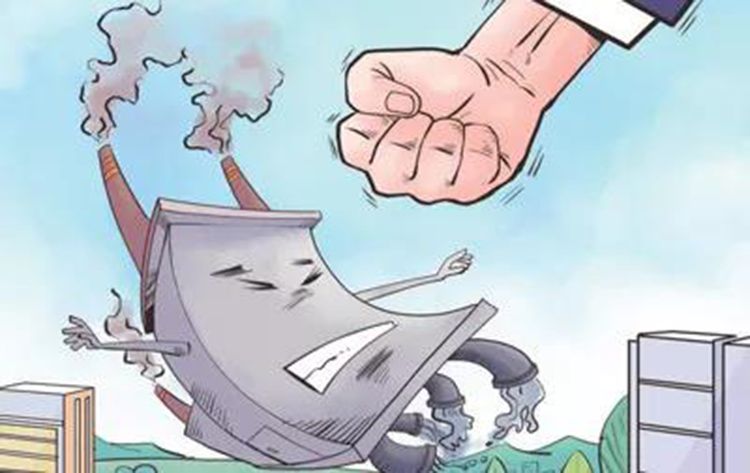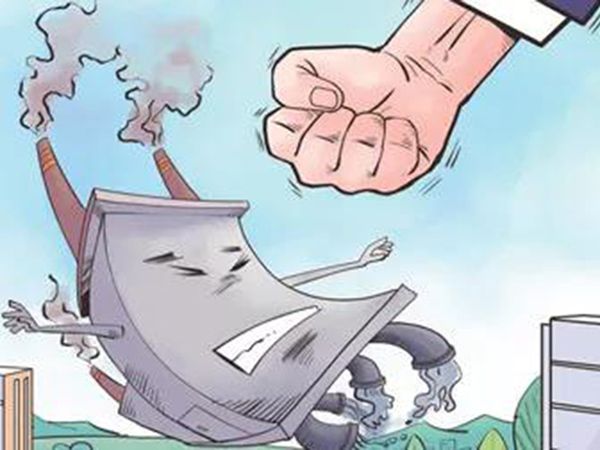
[headlines] since March 1st, the "2+26" city has implemented special emission limits for air pollutants.
[headlines] since March 1st, the "2+26" city has implemented special emission limits for air pollutants.
"By 2020, the average concentration of PM2.5 in unqualified cities in China will be reduced by more than 18% compared with that in 2015, and the proportion of good days in cities at prefecture level and above will be more than 80%. The annual National Conference on environmental protection held in recent days has set new targets for air pollution prevention and control, and brought new expectations to the people who have harvested more happiness in the blue sky.
We need comprehensive strategies to win the blue sky defense. According to the Ministry of Environmental Protection's Announcement on the Implementation of Special Emission Limits for Air Pollutants in Beijing-Tianjin-Hebei Air Pollution Transport Channel Cities, on March 1, the special emission limits have been implemented in industries and new projects of boilers that have specified the special emission limits for air pollutants in the national emission standards. This means that the first "weaponry" in the ammunition depot has been put into actual combat in the three-year campaign to win the Blue Sky Defense War, which is about to be launched in an all-round way.

1
The pollutant discharge standard is above 80%, and the emission reduction effect will be very significant.
The so-called special emission limits are higher and stricter than the national standards for pollutant discharge. It is self-evident that special emission limits should be implemented in Beijing-Tianjin-Hebei air pollution transmission channel "2+26" cities.
In February 2013, the Ministry of Environmental Protection issued the Announcement on Implementing the Special Emission Limits of Atmospheric Pollutants, requiring thermal power, iron and steel, petrochemical, cement, non-ferrous metals, chemical industry and coal-fired boiler projects in 19 provinces (districts, municipalities) of Beijing, Tianjin, Hebei, Yangtze River Delta and Pearl River Delta. Implementation of special emission limits for atmospheric pollutants.
According to the requirements at that time, Beijing, Tianjin, Hebei and the surrounding areas of Beijing, Tianjin, Tangshan, Langfang, Baoding, Shijiazhuang, Jinan, Zibo in Shandong Province and Taiyuan in Shanxi Province implemented special emission limits.
With the deepening of scientific research, the concept of "Beijing-Tianjin-Hebei Pollution Transmission Channel City" has become a consensus. Last February, the Ministry of Environmental Protection issued the Work Programme of Air Pollution Prevention and Control in 2017 in Beijing-Tianjin-Hebei and its surrounding areas. For the first time, the passageway city was called "2+26" city, and put forward the requirement of implementing special emission limits. By the end of September 2017, special emission limits for sulphur dioxide, nitrogen oxides and particulate air pollutants from all steel and coal-fired boilers in the "2+26" urban administrative region were specified in the documents at that time.
Compared with the announcement in 2013 and the February 2017 version of the plan, the industries and regions that implement the emission limitation requirements have expanded to varying degrees. The scope of implementation is not only extended from nine cities to "2+26" cities (including Xiongan New District, Xinji City, Dingzhou City, Gongyi City, Lankao County, Slip County, Changyuan County and Zhengzhou Airport District), but also from the main urban area to the whole administrative area.
Announcement Requirements: For industries that have set special emission limits in the national standards for pollutant discharge, special emission limits shall be fully implemented, including 25 industries or sub-industries such as thermal power, steel, coking, chemical industry, non-ferrous metals, cement, boilers, etc. Compared with the announcement in 2013, the scope of implementation of new enterprises has increased the coking industry, while the scope of implementation of existing enterprises has increased the coking, cement, non-ferrous and chemical industries.
What is the difference between the implementation of special emission limits and the implementation of general national standards? Several examples can be seen briefly.
For example, in the coking industry, the emission of particulate matter from the existing enterprise coke oven chimneys in the national standard can not exceed 50 (in milligrams/cubic meters, the same below), the sulfur dioxide concentration standard of machine coke and semi-coke oven chimneys is 100, and the emission standard of nitrogen oxides is 800. The emission limits for particulate matter in coke oven chimneys are 15, and the emission standards for sulfur dioxide and nitrogen oxides are 30 and 150, respectively. That is to say, the special emission limit is 70% of the concentration of particulate matter and sulfur dioxide, and the concentration of nitrogen oxides is only about 18% of the standard.
For example, the emission standards of atmospheric pollutants from coal-fired boilers are 80, 400 and 400 for particulate matter, sulfur dioxide and nitrogen oxides respectively, while the corresponding values of special emission limits are 30, 200 and 200, with a 50% decrease.
It can be seen that the special emission limit is indeed a sharp tool to reduce the total amount of pollutant emissions, which is undoubtedly a "major advantage" for the "2 + 26" cities in the second phase of the Blue Sky Defense War.
2
The implementation time limit is realistic enough to provide sufficient buffer, and the deadline will not be reached.
From the draft to the actual landing plan, the implementation period has changed slightly, leaving a buffer period. For example, in the draft, existing coking enterprises are required to implement special emission limits from June 1, 2018, while in the actual plan, the time limit is extended to October 1, 2019. The implementation period of EIA has also been extended from 1 June last year to 1 March 2018 for industries with special emission limits for atmospheric pollutants and new boilers in national emission standards.
The significance of raising standards lies in effective implementation. Shi Minjun, a professor at the School of Economics, Renmin University of China, believes that delays in execution and buffer periods reflect the pragmatic spirit of environmental protection departments. It is very important for the relevant industry enterprises to have enough time to upgrade and upgrade.
Special emission limits relate to more industries. Are these industries able to withstand such stringent emission requirements? "The limit value is the issue of emission permits in economics. To raise the limit is to recover part of the emission right by the government. Some enterprises need to raise the cost of pollution control, while others may not be able to do it at all. Only change their professions. Professor Li Zhiqing, deputy director of environmental economics research center of Fudan University, said this.
Upgrading of emission standards is the general trend. In recent years, China's environmental standards have been constantly revised and updated, including the emission standards of cement, steel, petroleum refining, petrochemical and other industries have been tightened to varying degrees, effectively guiding the process of industry cleanliness. But the environmental transformation of the industry also needs to overcome many difficulties.
From the implementation of the new national standard in 2012, to the implementation of ultra-low emission transformation later, to today's special emission limit requirements, although there are always people shouting at each node, but under strict requirements and supervision, the established goals can be achieved. Therefore, the emission reduction in the electricity industry seems to be a template.
Can other industries successfully upgrade the emission level according to this path? In this regard, different industries have different views: without the subsidies policy of thermal power industry, it is more difficult to reach the limit, but it is also a process of re-shuffling for the industry. Those who have the ability and strength to raise the bid and transform will survive without any problem, and will stand out in the competition, while those enterprises with relatively backward technology and equipment will only go to the end.
Industry enterprises in the list should reach the special emission limits of atmospheric pollutants within the prescribed time limit. If the overdue time is still not reached, the relevant departments shall, in strict accordance with the requirements of the law, order corrections or restrictions on production, stop production and rectification, and impose fines; if the circumstances are serious, they shall be reported to the people's government with the power of approval and ordered to close down or close down.
3
The threshold for environmental protection is generally improving, and there is no possibility of large-scale industrial pollution transfer.
In fact, before the introduction of special emission limits, emission standards in many places have been stricter than the national standards, which makes many high-emission industries move to more relaxed areas. Under strict limits, will there be another wave of so-called industrial transfer of pollution?
Shi Minjun believes that, in theory, industrial transfer is a natural phenomenon with its own rationality. Transfer is the strategy of an enterprise, and it is also an opportunity for an enterprise to improve itself. Unlike global pollutants such as carbon dioxide, environmental problems caused by atmospheric pollutants are closely related to regional environmental capacity. If these pollutants are transferred to a reasonable place, they are effective in reducing environmental hazards. But the premise of reasonable transfer is that the "threshold" needs of the receiving area are linked to the environmental capacity.
"Even if the polluting industry wants to transfer, it must find a place to undertake. As far as the present situation is concerned, the central government is guided and local execution will surely go up to a higher level. It is unlikely that the large-scale and simple transfer of pollution will be realized. There may be some local phenomena that some high-polluting industries and enterprises flow to standard depressions because of different standards. Li Zhiqing said so.
"Strict on this side, loose on the other side, a boundary between, polluting enterprises have run over, the emission of pollution and ultimately affect the air quality here." This reporter recently heard a lot of complaints in Taiyuan. Local cadres said reluctantly that, because the "threshold" is not the same high, some enterprises did not transform the technical equipment, moved several kilometers, and started work again. Because of the closer distance, the air quality of the passageway cities is still in effect. How to better translate the special emission limits into real emission reductions remains to be better coordinated at the operational level.
The positive impact of implementing special emission limits on environmental protection is obvious, but Li Zhiqing cautions that its impact on local economy and industry should also be assessed.
"It is theoretically valid to promote development with the new green regulations, but because of the great differences in local areas and different resources endowments, it is impossible for all regions to develop finance, science and technology and other industries, and it is also necessary for them to operate in dislocation." He believes that it is necessary to implement special limits in specific areas, but in the long run, policy-making should also focus on allocating limited environmental capacity to the most efficient enterprises, so as to form a win-win situation between industry and environmental protection.
Compared with the "limited" industry, this policy will have a significant positive impact on the environmental protection industry. Professionals believe that the market prospects will be very broad, especially in the non-electric industry.
(source: People's daily, reporter: Sun Xiuyan)





